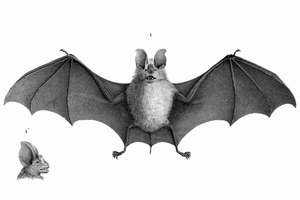Trident leaf noses
| Trident leaf noses | ||||||||||||
|---|---|---|---|---|---|---|---|---|---|---|---|---|

Asellia tridens |
||||||||||||
| Systematics | ||||||||||||
|
||||||||||||
| Scientific name | ||||||||||||
| Asellia | ||||||||||||
| Gray , 1838 |
Trident leaf noses ( Asellia ) are a genus of bats in the family of round leaf noses (Hipposideridae) with four species that occur in Africa and Asia .
In a revision of the genus from 2011, four types are distinguished:
- Asellia arabica occurs in the south of the Arabian Peninsula .
- Asellia italosomalica from Somalia and the island of Socotra .
- Patrizi's trident leaf nose ( Asellia patrizii ) lives in Ethiopia and Eritrea .
- Geoffroy's trident leaf nose ( Asellia tridens ) occurs from North Africa across the Arabian Peninsula to Pakistan .
features
These bats reach a head-trunk length of 46 to 62 mm and a tail length of 16 to 29 mm. Their weight is 6 to 10 g. The color of the fur varies greatly between the different populations, some are light gray with pink shades and others have an orange-brown to yellow fur. It is named after a nose leaf in the shape of a trident , which connects to the central triangular leaf. There is also a horseshoe-shaped leaf in front of the central triangle. The species have large, almost bare ears.
Way of life
Trident leaf noses live in deserts , dry grasslands or in mountains. They rest in caves and other natural cavities, often in oases . The animals form colonies of a few hundred to about 5,000 specimens at the resting place . Occasionally there are mixed colonies with the white-rimed bat ( Pipistrellus kuhlii ) or with species of the genera Coleura or Triaenops . In hiding, trident leaf noses can withstand temperatures of 38 ° C. In colder regions like northern Iraq , however, they hibernate for two months . Groups of around 20 specimens go on the hunt.
Several captured females were pregnant with one embryo . It is estimated that there are 9 to 10 weeks between mating and birth. The young will probably be suckled for 40 days.
status
The species are occasionally disturbed in their resting places. The use of pesticides in agriculture also has negative effects. These factors are less relevant for the overall population and so two types are listed by the IUCN as " Least Concern " .
Reference literature
- Ronald M. Nowak: Walker's Mammals of the World. 2 volumes. 6th edition. Johns Hopkins University Press, Baltimore MD et al. 1999, ISBN 0-8018-5789-9 .
Individual evidence
- ↑ Petr Benda, Peter Vallo and Antonín Reiter. 2011. Taxonomic Revision of the Genus Asellia (Chiroptera: Hipposideridae) with A Description of A New Species from southern Arabia. ( Memento of the original from April 12, 2016 in the Internet Archive ) Info: The archive link was inserted automatically and has not yet been checked. Please check the original and archive link according to the instructions and then remove this notice. Acta Chiropterologica. 13 (2); 245-270. DOI: 10.3161 / 150811011X624749
- ^ A b c Ronald M. Nowak: Walker's Mammals of the World. Volume 1. 6th edition. 1999, pp. 337-338, Trident Leaf-nosed Bats .
- ↑ a b Asellia in the IUCN 2012 Red List of Threatened Species . Accessed December 13, 2014.
